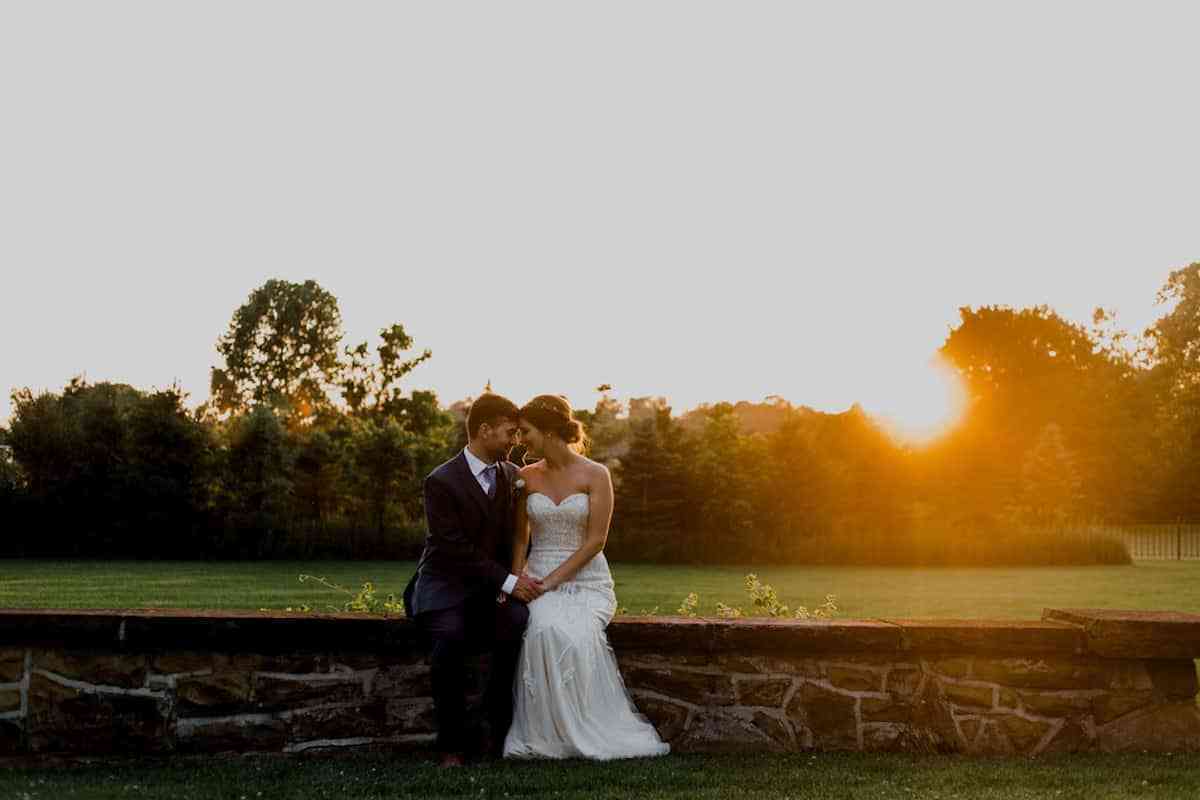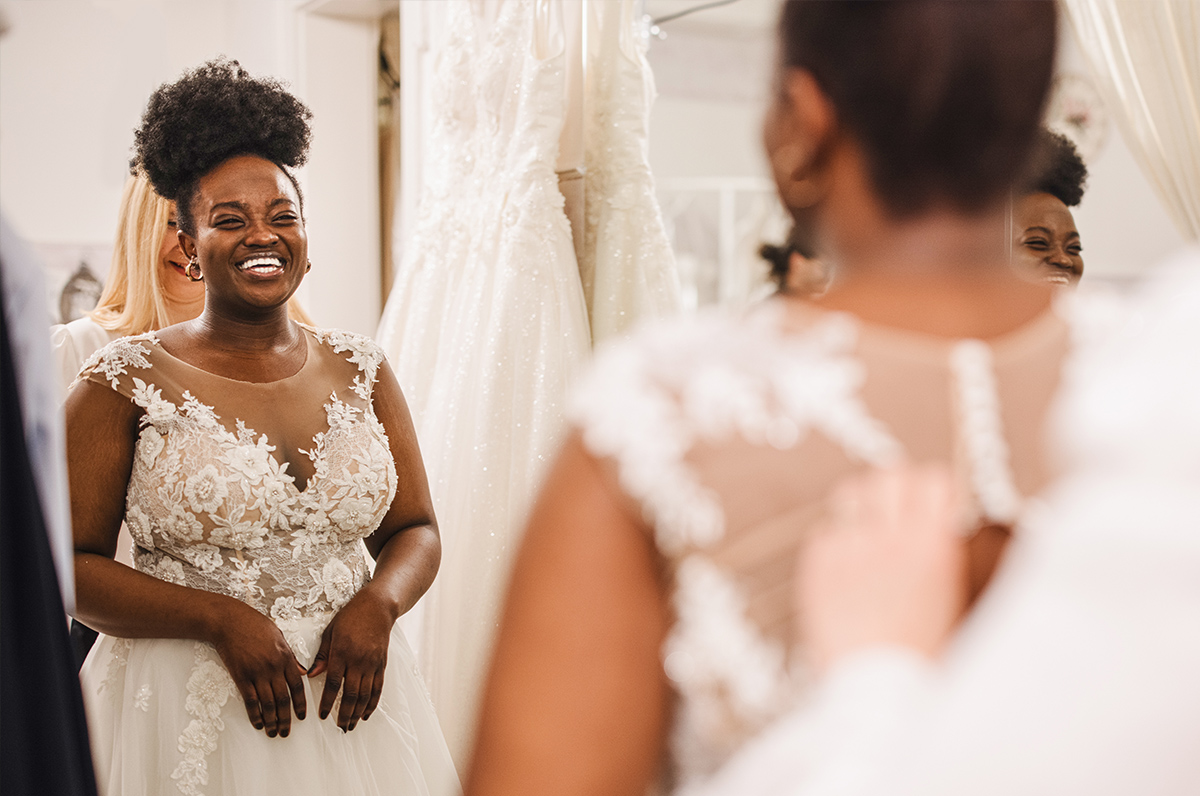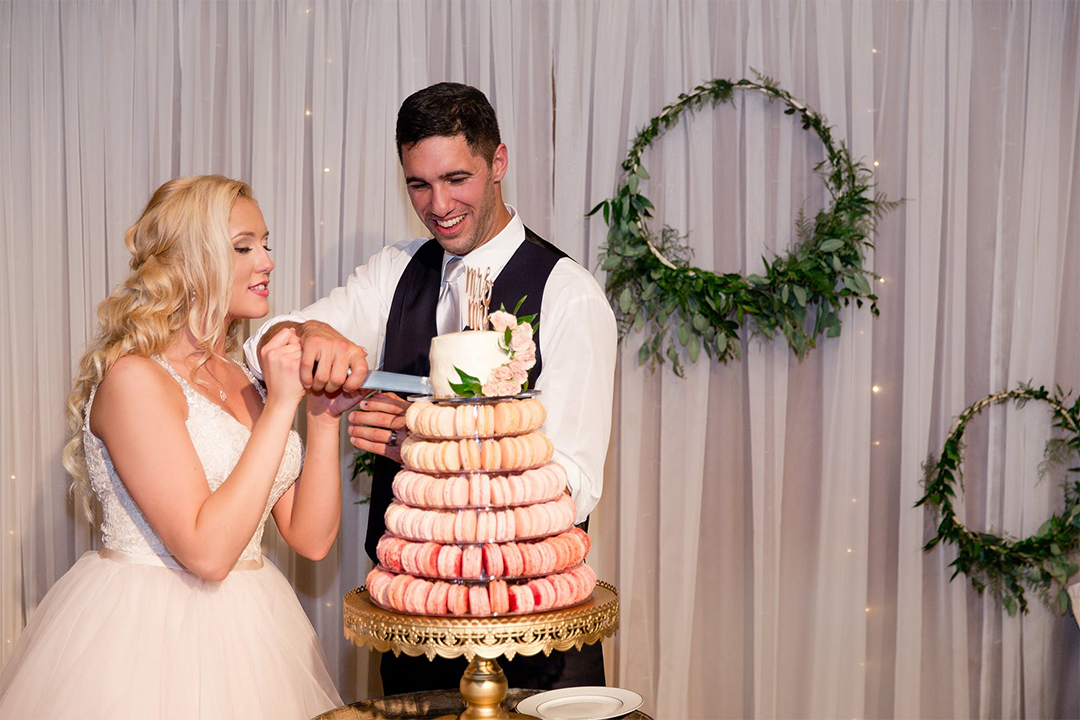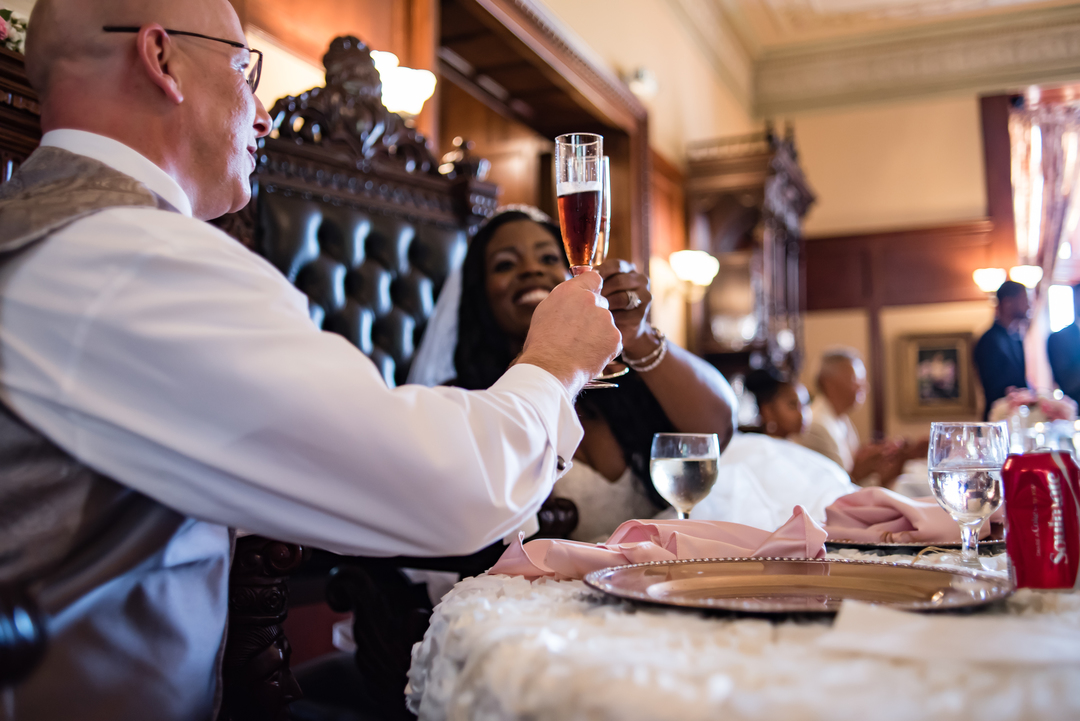- Expert advice/
- Wedding planning 101/
- Creating a budget/
- 29 Ways to Cut Wedding Costs
- Creating a budget
29 Ways to Cut Wedding Costs
Need to cut wedding costs? Here are five ways to do so that you might not have thought about. Read up, and get ready to spend smart!
Last updated September 10, 2025

It’s not breaking news—we’ve said it in wedding planning a hundred times—that (most) weddings cost a lot of money. The cost of weddings can be one of the biggest stressors of wedding planning, period. But any wedding planner worth their salt will also tell you that, with a few smart moves and some ground-laying decisions, you can still throw an incredible, memorable wedding that guests will rave about for years while sticking to a reasonable budget.
Below, we’ve compiled a list of tips that’ll help you save money and stick to your wedding budget. Read on for useful ways to cut wedding costs that you might not have thought about.
How much can a wedding cost?
According to Zola's First Look Report, the average cost of a wedding in the U.S. sits between $20,000 - $40,000. That said, this can vary widely depending on state. For example, Kansas’ average is $17,000, whereas DC’s is $44,000. This likely comes down to denser populations, more touristy cities (meaning more demand), and a higher cost of living in any given area.
29 Money-saving wedding tips
Don’t let the bottom lines frighten you too much. There are plenty of ways you can cut costs and save money throughout the wedding planning process.
1. Prioritize 2-3 things
Perhaps the most important step you can take in planning your beautiful, budget-friendly wedding is to decide which two or three aspects of the wedding experience are most important to you and your partner. Whether it’s a gourmet meal, a killer live band, or a really incredible venue with a view, determine your top handful of priorities and put the majority of your budget towards those areas. Then, let go of the other stuff.
2. Shrink your guest list
This is basic math, friends. The higher the number of guests you have to invite, seat, feed, serve drinks, transport, or provide with little extras like favors or welcome bags, the higher your wedding expenses will climb. If you want to include all of those amenities I just mentioned in your wedding weekend (i.e., printed invitations, food, alcohol, transportation, ceremony seating, reception tables and chairs, décor for all those tables, wedding favors, and welcome bags), then do your best to keep your guest list as streamlined as possible.
3. Book a full-service venue
The average cost of renting a venue for your ceremony and/or reception is over $3,000—and that’s just the rental fee alone. Imagine adding in additional costs for catering, alcohol and bar services, equipment rentals (think tables, chairs, linens, glassware, etc.), and a day-of coordinator. As you can imagine, the total figure can be really overwhelming. For this reason, full-service venues that offer a package deal for all of the above services can actually be cost-saving in the end.
4. Rethink wedding venues
We mean it literally when we say that your wedding ceremony (as well as the following celebration) can take place just about anywhere. And, seeing as wedding venues are one of the most costly aspects of a wedding, it’s worth it to consider more affordable options. Charming at-home weddings, for example, have been growing in immense popularity since the beginning of 2020. In these cases, couples will decorate and have their vendors present at their own homes for their ceremony and reception. This can be lovely, as well as low-stress and inexpensive.
5. Have a destination wedding
At first, a destination wedding probably seems like the opposite of money-saving. That said, hosting an intimate (read: small guest list) destination wedding in another state or even country can end up costing less than a large affair in your area. This is especially the case when you go the Airbnb route, which can also provide accommodations to you and your guests. If having a smaller wedding in another locale sounds even a little exciting to you, we recommend looking into and comparing costs.
6. Choose a less popular wedding date
Peak wedding season throughout most of the U.S. runs from April through October, with June, September, and October being the most popular months to get married (hello, summer breezes and crisp foliage). To save some beaucoup bucks, book a date that falls during the off-season for discounted rates at venues. Winter weddings can be truly spectacular and open up a whole new avenue for unique attire, décor, and weekend guest activities.

7. Explore days beyond Saturdays
We know this one can be tough. But for even greater savings, explore a day of the week outside of Saturday evening. Venue rentals on Fridays, Sundays, and even other weekdays go for a lot less money as they’re less in demand. If this isn’t appealing to you, consider a daytime celebration, such as a brunch wedding, which will help offset costs by allowing you to serve a smaller meal and less alcohol, as well as book more low-key entertainment than what’s typically expected at an evening affair.
8. Reconsider the traditional wedding party
Some people can’t picture their big day without the traditional wedding party, complete with maid of honor, best man, bridesmaids, groomsmen, flower girl, ring bearer, and the parents of the couple. But, as you can likely tell, this portion of a wedding involves a lot of people. And where there are special groups of people, there tend to be extra expenses.
9. Go digital for wedding invitations
It seems that all things wedding are starting to turn to the internet. Wedding websites and digital RSVPs are just a couple examples of convenient online tools that have largely improved the wedding planning process—for both hosts and guests. To save some cash, ask yourself if you can also switch out paper invitations for digital ones. Gauge your guests’ preferences and likelihood to respond via website or email.
10. Shop far and wide for a wedding dress
Wedding dresses aren’t exclusive to wedding boutiques and designers. There are plenty of more affordable places to look for your dream gown. From sample sales to less expensive retailers to preowned wedding dresses (more on that below), there are a variety of stores and sellers that can provide you with your ideal dress without breaking the bank.
11. Buy preloved wedding attire
Wedding gown expenses tend to be all over the map, from surprisingly affordable to jaw-droppingly expensive. For the bride who wants a higher-end dress without paying the usual price for one, consider purchasing a preowned wedding dress. Websites like Still White and Nearly Newlywed allow former brides to list their new and gently used gowns for others to purchase. Not only is this good for the environment, but your wallet, too. Grooms can also save by finding preloved suiting and attire.
12. Repurpose a wedding dress
If your mom, mother-in-law, or even grandmother's wedding gown is collecting dust in the attic, it's worth giving it another look. If someone in your family is skilled at sewing, you can repurpose a vintage dress that has been in the family, which will save money and add some extra sentimental value to your look. Even if you have to hire someone to recreate and tailor it, it will still be cheaper than a new, off-the-rack gown.

13. Rent or borrow jewelry
Your best wedding attire doesn’t require you to drop tons of money on new accessories. However, if you prefer to wear some eye-catching jewelry with your wedding dress, jumpsuit, or suit, look into jewelry rental companies. Many online companies will rent out pricey jewelry at a much lower cost—the only downside is that, after the fact, you’ll have to send it back. Otherwise, ask a loved one with impeccable style if you could borrow something of theirs, also fulfilling the something borrowed tradition.
14. Rethink wedding party flowers
As we’re sure you’re aware, florals can be pretty expensive. If you’re looking for areas where you can cut your budget, look to your bridesmaids’ bouquets and groomsmen’s boutonnieres. Bridesmaid bouquets can be pared down and minimal, consisting of a few fuller flowers and some greenery for a minimal and cost-effective result. Likewise, groomsmen (as well as the groom) can skip the boutonnieres and instead purchase less expensive pocket squares or pins.
15. Skip cocktail hour
This money-saving option won’t always be ideal—or even possible—but it shouldn’t be taken off the table entirely. Some weddings, especially those that are smaller, can actually benefit from going from the ceremony straight to the reception. This is often the case if you plan on having food and drinks of some sort (dinner or apps) immediately available to guests upon arrival. This will ultimately save you money on food, alcohol, and service. If you choose to do this, just be sure to notify your guests both on your invitation and wedding website.
16. Skip the open bar
There’s a large misconception out there that the one thing your guests are most looking forward to on your wedding day is an open bar. This couldn’t be more false as they want to help celebrate your love. While an open bar may be very convenient and loosen people up, it’s by no means required at your reception. Less expensive options include limiting your bar to a few wines and beers, offering select signature cocktails, and purchasing your own alcohol to bring to your venue (check to see if this is allowed first).
17. Consider entrée alternatives
Sometimes plated wedding meals are the most expensive option, but not always. Sit down with your caterer and discuss some alternative ways to feed your guests that might cut down your catering bill. For example, opt for a cocktail-style reception with plenty of heavy hors d’oeuvres (which can help lower table and chair rental costs), or go for interactive and/or DIY food stations that will keep guests both entertained and well-fed. However, sometimes appetizers can be more expensive because of the labor involved, so chat with your caterer about the best options.
18. Swap out the wedding cake
Wedding cakes can be unexpectedly costly (with the average price usually landing between $300 and $700 or more). If cake isn’t your favorite type of dessert and/or you aren’t committed to tradition, consider instead ordering something else. Some alternatives we love are croquembouche, cannolis, macarons, doughnuts, pies, and cupcakes. Don’t want sweets? Plan on a cheesecake—as in a cake made of stacks of cheese to serve as part of a charcuterie. Brilliant!

19. Buy local, in-season flowers
Sure, mountains of roses and armfuls of peonies are as romantic as they come, but there are so many other, less pricey stems that will make just as beautiful a statement (without blowing your wedding budget). If you love the look of petal-rich blooms, consider garden-grown dahlias or the peony-lookalike ranunculus. Most importantly, stick to flowers that are in season when and where you’re getting married. You’ll pay considerably more for flowers that have to be flown in from other regions or countries.
20. Consider herbs over florals
For a wedding budget-friendly way to incorporate lots of greenery, texture, and fragrance into your bouquets and arrangements, ask your florist about incorporating fresh herbs. Everything from basil to rosemary to mint is fair game, not to mention more floral herbs like lavender. They’ll add a note of organic elegance, not to mention uniqueness, to your wedding décor that will make roses seem ho-hum.
21. DIY your centerpieces
Because professional floral and greenery centerpieces can be fairly expensive, one way to save money is to go the DIY route. The options here, creatively, are virtually endless. A centerpiece can be a single candle, a stack of some of your favorite books, a beautiful bowl of fruit, or a single-stemmed flower in a small glass vase.
22. Make your signs
We know those custom acrylic welcome and seating signs are absolutely beautiful. That said, they can also be a bit pricey. If you’re even a little crafty—or have a friend who is and is willing to help you out—you can easily create your own signage for the cost of supplies. This alternative can be especially appealing to those hosting cottagecore, barn, or shabby chic weddings, as the homemade look will seamlessly fit into your celebration.
23. Forego the video
This one truly pains us to say, but if organizing your budget comes down to choosing either a photographer or videographer, always opt for a photographer. Wedding videos can be incredibly beautiful and fun to watch, but chances are you won’t look back on one as much as you will on photographs from your wedding. If skipping this popular wedding vendor can save you some much-needed money, do it.
24. Make a reception playlist
Though DJs and live bands can be wonderful for managing the night’s timeline and encouraging the crowd, they aren’t always necessary. If you’re hosting a wedding that’s on the smaller side and have a good ear for crowd-pleasing music, consider instead going with a playlist. You know your loved ones best, so odds are you know just the kind of music that’ll get them out on the dancefloor, anyway. Just make sure you avoid harsh transitions.

25. Skip insignificant details
While it may seem important to you, chances are your guests won’t remember your hand-painted envelope liner, heavier cardstock, or custom napkins. These small details are fun to find and plan out but will ultimately end up adding significantly to your bottom line. Truly ask yourself throughout wedding planning if small, added details are necessary or very important to you. If not, skip right ahead.
26. Pass on wedding trends
The month’s or year’s hottest wedding trends may seem to be everywhere right now, but don’t feel pressured to include any that you don’t genuinely love. For example, if a wedding reception photo booth set-up isn’t something you’re into (or, say, it doesn’t go well with your venue or theme), don’t feel the need to spend money on one. While it might seem like something huge right now, odds are your guests won’t even notice one of these passing trends isn’t present.
27. Have a dry wedding
If alcohol isn’t that important to you or your partner, then why have it? Sure, some of your guests might like to drink a cocktail or two, but you can save some serious money by serving soft drinks only. Mocktails and zero-proof cocktails are also super en vogue at the moment, so capitalize on the trend and skip the alcohol.
28. Resell post-wedding
Definitely don’t waste anything you may have purchased for your wedding. Nearly everything from your dress to vases and chair covers to headpieces can be resold for a pretty decent value. Don’t bank on making a certain amount, but you can look forward to at least making something back, which would lower the overall total cost of your big day.
29. Hire beginners
If you really want a videographer or if having picture-perfect wedding day photos isn’t at the top of your priority list, you can hire emerging or amateur professionals. Then your photos and videos will cost a fraction of what a highly sought-after professional would charge. They might not be magazine-worthy, but they’ll have captured the moment, which is what matters most.
30. Have a friend officiate
If you’re having a religious ceremony you’ll likely have to be married by a religious figure. But if not, you can have a friend officiate your ceremony at zero cost to you. Not only will they feel honored that you asked, you won’t have to pay a dime and it will add an extra special, personal element to your ceremony.
Is that your wallet or credit card we hear breathing a sigh of relief? We hope so. If you follow some of these tips for how to cut costs, you can still throw the stylish, cohesive wedding of your dreams while sticking to your wedding budget. No need to splurge. Now, that’s a cause for celebration (but your enduring love and devotion are also totally worthwhile). If you’re still looking for tips, Zola has plenty of budget-saving advice for you to explore.
Up next for you

Best Ways To Start Saving For Your First Home Together
Finances
The thank-you notes are mailed, the honeymoon is over, and you and your partner are finally starting your lives together. Buying your first home is a major hurdle, but with some smart planning, you can land the home of your dreams and stay within your budget.

Average Cost of Weddings in 2025: Vendor Price Guide
Advice
Average cost of weddings in 2025: See national averages for venues at $8,573 and catering at $6,927, plus key vendor costs to plan your budget.

How to Set Your Wedding Budget Step by Step
How-To
While it may not be the most exciting item on your to-do list, setting your wedding budget is essential. We’ll break down the typical expenses, guide you through the entire process from start to finish, and tell you where you can save money.
Featured

How Much To Tip Wedding Vendors
Inspiration
Confused on how much to tip wedding vendors, which vendors to tip, and when to distribute tips? Fear not: explore our guide for tipping wedding vendors.

How to Negotiate With Wedding Vendors
How-To
Wedding vendors make up the majority of a wedding budget. Find out how to negotiate with wedding vendors with our guide.

How to Write a Wedding RFP
How To
A wedding RFP, or request for proposal, is an easy way to outline your wants, needs, and limitations for each of your prospective wedding vendors. Here's how to write a wedding RFP that will get you what you want.

How to Book Hotel Rooms for Your Wedding Guests
How-To
Check out our comprehensive guide on how to book hotel rooms for your wedding guests to learn the ins and outs of this sometimes-tricky task.
- Expert advice/
- Wedding planning 101/
- Creating a budget/
- 29 Ways to Cut Wedding Costs
Find even more wedding ideas, inspo, tips, and tricks
We’ve got wedding planning advice on everything from save the dates to wedding cakes.
